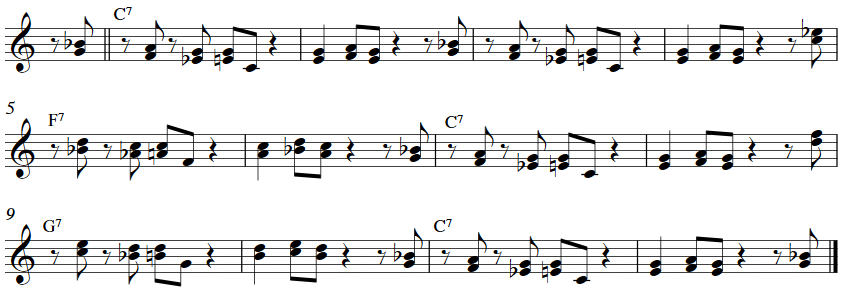As pianists, we’re always looking for fun, bluesy piano licks to add to our bag of tricks. In this article I’ll show you a couple great bluesy licks AND how to transpose them for use across a 12-bar blues form. These licks can be used in a variety of styles of playing – blues, boogie woogie, jazz, rock, country, etc. Let’s check ’em out!
Lick #1
The first blues piano lick is two measures long and works over a single dominant chord. We’re going to look at it in the key of C (over a C7 chord) in 4/4 time.
Be sure to practice this lick with your metronome, starting slowly and gradually increasing your speed. Once you’ve mastered the lick as written above, the next issue is being able to transpose it through the 12-bar blues form.
Transposing the Lick
The important thing to remember about the 12-bar blues form is that it moves through three different primary chords – the I, IV, and V chord. So in order to use this lick throughout an entire chorus of the blues form, we’ll need to be able to transpose the lick through these 3 tonal centers. Doing this in the key of C means that we’ll be moving the lick through C7 (above), F7 (the IV chord), and G7 (the V chord).
Let’s move the lick first to F7. Looking at the lick in the original key of C7, we see that beat 1 begins on the flat 3rd and 5th of C7 and then resolves to the natural 3rd and 5th. In F7, the lick start on these same intervals of course, those being ‘Ab’ and ‘C,’ and then ‘A-natural’ and ‘C.’
What about G7? What are the flat 3rd/5th and natural 3rd/5th in G7?
Proceeding this way will allow us to transpose the entire lick to each of these 3 tonal centers. Once you’ve worked through each of these keys (C7, F7, and G7) in isolation, practice playing the lick through the entire 12-bar blues form as below.
Lick #2
Lick #2 is closely related to lick #1 but adds some more rhythmic syncopation.
Working through this lick in the same manner as above, we can move it through the three tonal centers – the I, IV, and V chords (C7, F7, and G7) – in order to play this lick through the entire 12-bar blues form.
The next step towards making these licks work for you is to be able to play them on command, with the ability to go back and forth between the two licks at will.
If you enjoy studying blues piano licks, we recommend checking out our 15 Blues Licks lesson!






